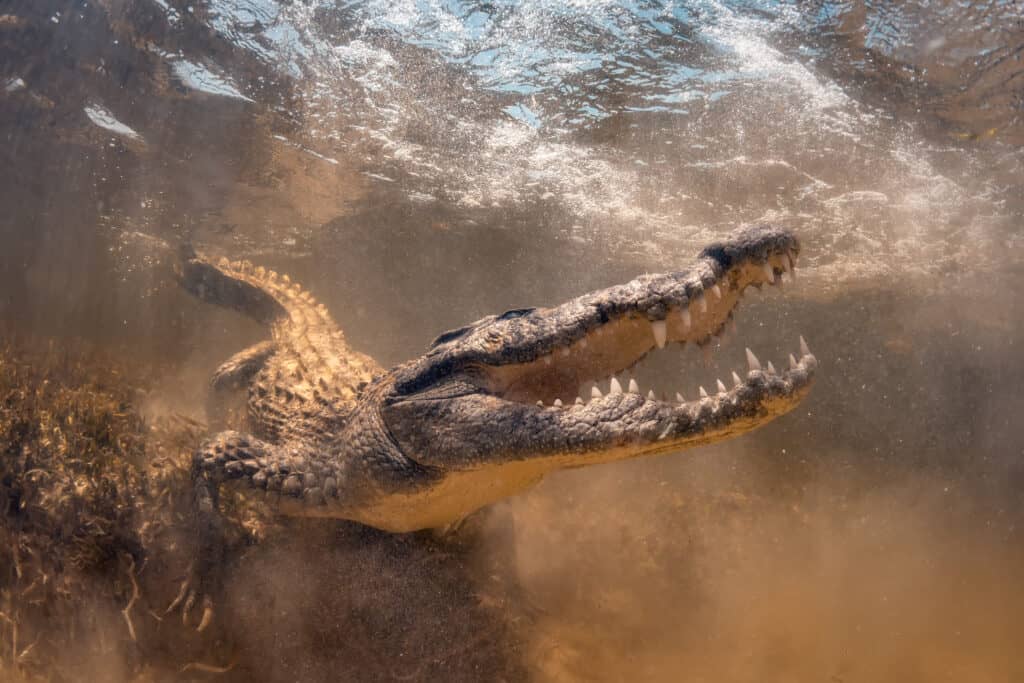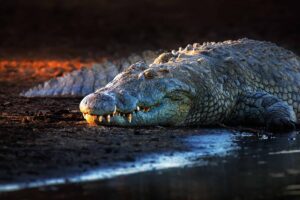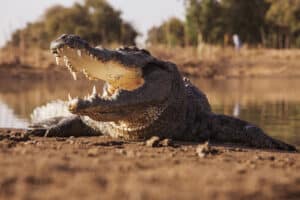Serenity Is Shattered When a Crocodile Explodes From a Watering Hole!
In the heart-gripping and suspenseful video at the top of the page, a giant mugger crocodile expertly ambushes a herd of deer. The clip begins with a snapshot of the action, showing the ferocity with which the crocodile attacks. In this quick slow-motion moment, we get an up-close look at the terrifying agape jaws of the crocodile. But equally impressive and impossible to miss are the remarkable reflexes and acrobatics performed by the deer.
As the video resumes, the narrator explains the precarious situation in Sri Lanka, the clip’s setting. The area is dry, and finding water is a matter of life or death for all the animals here, including a herd of deer. Luckily, the herd found an oasis in the dry landscape—a watering hole. A huge number of different species coexist around the watering hole, from the deer to buffalo, monitor lizards, monkeys, and even elephants.

While mugger crocodiles may be slow and unthreatening on dry land, they transform into highly capable hunters in the water!
©Gelia/iStock via Getty Images
But while all these animals come to the watering hole to drink, the mugger crocodiles are there to eat. While cumbersome and slow on land, these reptilian beasts are experts in aquatic ambushes. Hiding under the surface of the water, the crocodile makes repeated attempts to snatch a deer risking a drink. The deer are too quick, though, and they retain their advantage on dry land. Until an unlucky deer jumps the wrong way, right into the water, and the jaws of the crocodile. With one of the strongest bite forces in the animal kingdom, once a mugger crocodile has prey in its jaws, escape is unlikely.
Mugger Crocodiles: The Man-Eating Beasts of South Asia?
Mugger crocodiles pose a serious threat to human safety. They’re known for their aggressive behavior and are capable of dealing out serious damage. These crocodiles, native to South Asia, are the fourth-largest species, reaching lengths of up to 13 feet. With a lifespan of over 50 years, their diet includes fish, amphibians, and even snakes. Yet a scary addition to their diet is human!

Saltwater crocodiles, like the one pictured above, continue to pose an even bigger threat to mugger crocodiles.
©Alexander Machulskiy/Shutterstock.com
Recorded human deaths attributable to mugger crocodiles have been alarming. Particularly in India and Bangladesh, where incidents are most common. According to CrocBITE via Britannica, mugger crocodiles attacked 110 between the years of 2008 and 2011. The dense mangrove forests and river systems in these countries are the natural habitat, and perfect hunting ground for mugger populations. In response to the clashing between mugger crocs and humans, governments have initiated comprehensive plans. These plans incorporate both habitat management and public awareness programs.
Comparatively, mugger crocodiles exhibit a lower rate of human lethality than their counterparts. Nile crocodiles and saltwater crocodiles are responsible for more fatalities. Nonetheless, mugger crocodiles demand government attention due to their concentrated presence within certain countries and regions. The Ganges, Brahmaputra, and Indus river systems harbor large mugger populations, all heavily populated rivers, raising the risk to human communities.
The photo featured at the top of this post is © DINAL_SAMARASINGHE/Shutterstock.com
Thank you for reading! Have some feedback for us? Contact the AZ Animals editorial team.






